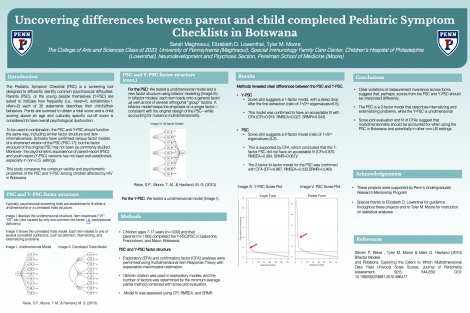Sarah Maghraoui
Uncovering differences between parent and child completed Pediatric Symptom Checklists in Botswana
Abstract
Background
The 35-item Pediatric Symptom Checklist was designed to identify psychosocial dysfunction in children. Parent-report (PSC) and youth-report (Y-PSC) versions are widely used in the U.S., but their psychometric equivalence has not been well-established. To be used in combination, it is important that these forms function the same way regardless of the reporter. This study compares the construct validity and psychometric properties of the PSC and Y-PSC among children affected by HIV in Botswana.
Methods
Children ages 7-17 years (n=1033) and their parents (n=1183) completed the PSC/Y-PSC in Gaborone, Francistown, and Maun, Botswana. Exploratory and confirmatory item-factor models were performed using multidimensional Item Response Theory with expectation-maximization estimation. Model fit was assessed using CFI, RMSEA, and SRMR.
Results
All methods revealed clear differences between forms, obviating fine-grained measurement invariance analyses. The optimal model for the PSC was a 2-factor, and a 1-factor model was best for the Y-PSC. The 1-factor Y-PSC model had acceptable fit (CFI=0.974, RMSEA=0.027, SRMR=0.043). The 2-factor model for the PSC was tested using a bifactor configuration to retain an overall score. This model was confirmed (CFI=0.967, RMSEA=0.033, SRMR=0.049). The correlation between the sum score and bifactor score was 0.83 (compared to 0.93 for Y-PSC).
Conclusions
Clear violations of measurement invariance across forms suggest that scores from the PSC and Y-PSC should be interpreted differently. Multidimensionality should be accounted for when using the PSC in Botswana and potentially in other non-US settings.
Keywords
Factor structure, HIV, Botswana, Pediatric Symptom Checklist, screening tools, psychosocial difficultiesCommenting is now closed.
About Us
To understand health and disease today, we need new thinking and novel science —the kind we create when multiple disciplines work together from the ground up. That is why this department has put forward a bold vision in population-health science: a single academic home for biostatistics, epidemiology and informatics.
© 2023 Trustees of the University of Pennsylvania. All rights reserved.. | Disclaimer




Comments